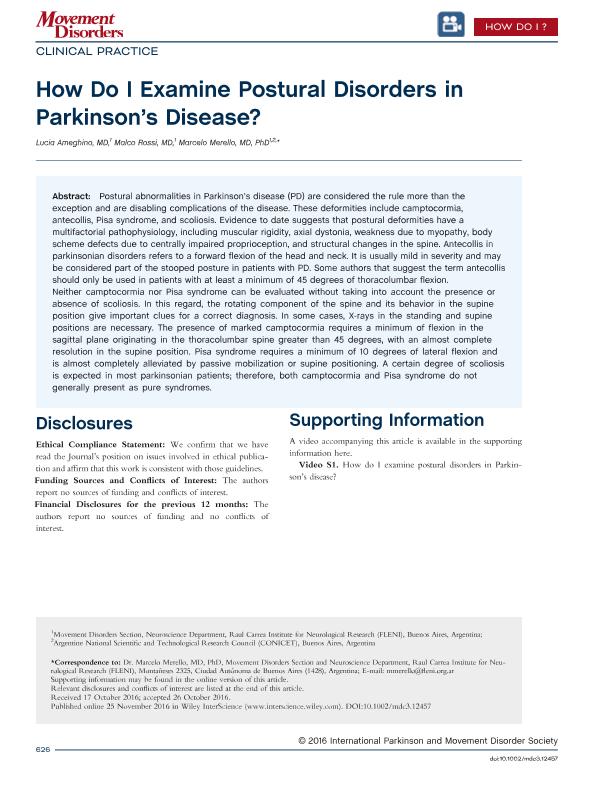Mostrar el registro sencillo del ítem
dc.contributor.author
Ameghino, Lucia
dc.contributor.author
Rossi, Malco Damián

dc.contributor.author
Merello, Marcelo Jorge

dc.date.available
2019-03-21T16:18:09Z
dc.date.issued
2016-11
dc.identifier.citation
Ameghino, Lucia; Rossi, Malco Damián; Merello, Marcelo Jorge; How Do I Examine Postural Disorders in Parkinson's Disease?; Wiley; Movement Disorders Clinical Practice; 3; 6; 11-2016; 626-626
dc.identifier.issn
2330-1619
dc.identifier.uri
http://hdl.handle.net/11336/72200
dc.description.abstract
Postural abnormalities in Parkinson's disease (PD) are considered the rule more than the exception and are disabling complications of the disease. These deformities include camptocormia, antecollis, Pisa syndrome, and scoliosis. Evidence to date suggests that postural deformities have a multifactorial pathophysiology, including muscular rigidity, axial dystonia, weakness due to myopathy, body scheme defects due to centrally impaired proprioception, and structural changes in the spine. Antecollis in parkinsonian disorders refers to a forward flexion of the head and neck. It is usually mild in severity and may be considered part of the stooped posture in patients with PD. Some authors that suggest the term antecollis should only be used in patients with at least a minimum of 45 degrees of thoracolumbar flexion.Neither camptocormia nor Pisa syndrome can be evaluated without taking into account the presence or absence of scoliosis. In this regard, the rotating component of the spine and its behavior in the supine position give important clues for a correct diagnosis. In some cases, X‐rays in the standing and supine positions are necessary. The presence of marked camptocormia requires a minimum of flexion in the sagittal plane originating in the thoracolumbar spine greater than 45 degrees, with an almost complete resolution in the supine position. Pisa syndrome requires a minimum of 10 degrees of lateral flexion and is almost completely alleviated by passive mobilization or supine positioning. A certain degree of scoliosis is expected in most parkinsonian patients; therefore, both camptocormia and Pisa syndrome do not generally present as pure syndromes.
dc.format
application/pdf
dc.language.iso
eng
dc.publisher
Wiley

dc.rights
info:eu-repo/semantics/openAccess
dc.rights.uri
https://creativecommons.org/licenses/by-nc-sa/2.5/ar/
dc.subject
Postural
dc.subject
Posture
dc.subject
Disorder
dc.subject
Parkinson
dc.subject.classification
Otras Ciencias de la Salud

dc.subject.classification
Ciencias de la Salud

dc.subject.classification
CIENCIAS MÉDICAS Y DE LA SALUD

dc.title
How Do I Examine Postural Disorders in Parkinson's Disease?
dc.type
info:eu-repo/semantics/article
dc.type
info:ar-repo/semantics/artículo
dc.type
info:eu-repo/semantics/publishedVersion
dc.date.updated
2019-03-21T14:19:03Z
dc.journal.volume
3
dc.journal.number
6
dc.journal.pagination
626-626
dc.journal.pais
Estados Unidos

dc.description.fil
Fil: Ameghino, Lucia. Fundación para la Lucha contra las Enfermedades Neurológicas de la Infancia; Argentina
dc.description.fil
Fil: Rossi, Malco Damián. Fundación para la Lucha contra las Enfermedades Neurológicas de la Infancia; Argentina. Consejo Nacional de Investigaciones Científicas y Técnicas; Argentina
dc.description.fil
Fil: Merello, Marcelo Jorge. Fundación para la Lucha contra las Enfermedades Neurológicas de la Infancia; Argentina. Consejo Nacional de Investigaciones Científicas y Técnicas; Argentina
dc.journal.title
Movement Disorders Clinical Practice
dc.relation.alternativeid
info:eu-repo/semantics/altIdentifier/doi/http://dx.doi.org/10.1002/mdc3.12457
dc.relation.alternativeid
info:eu-repo/semantics/altIdentifier/url/https://onlinelibrary.wiley.com/doi/full/10.1002/mdc3.12457
Archivos asociados
